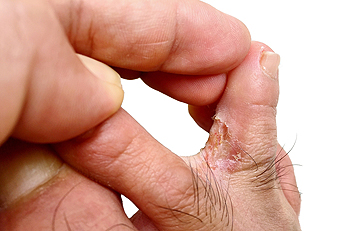
Athlete's foot, or tinea pedis, is a common fungal skin infection primarily affecting the feet. It presents with symptoms such as itching, peeling, and cracking, often occurring on the soles of the feet and between the toes. This contagious infection spreads through contact with contaminated surfaces, making environments like swimming pools and locker rooms potential hotspots. Wearing tight-fitting shoes exacerbates the issue by creating a moist environment conducive to fungal growth. Athlete's foot can manifest differently, such as toe web infections, moccasin-type infections, or vesicular infections. Diagnosis generally relies on visual examination, but sometimes skin or nail samples are tested for fungi. Adequate foot hygiene, including keeping feet clean and dry, changing socks daily, and wearing breathable shoes, plays a vital role in prevention and management. Medication is often prescribed for a successful recovery, and it is beneficial to complete the full course, even after symptoms subside. It is suggested for Individuals with diabetes or persistent infections to schedule an appointment with a podiatrist for more advanced care.
Athlete’s foot is an inconvenient condition that can be easily reduced with the proper treatment. If you have any concerns about your feet and ankles, contact Gabrielle Clark, DPM from LA Feet Foot & Ankle Center, Inc. Our doctor will treat your foot and ankle needs.
Athlete’s Foot: The Sole Story
Athlete's foot, also known as tinea pedis, can be an extremely contagious foot infection. It is commonly contracted in public changing areas and bathrooms, dormitory style living quarters, around locker rooms and public swimming pools, or anywhere your feet often come into contact with other people.
Solutions to Combat Athlete’s Foot
- Hydrate your feet by using lotion
- Exfoliate
- Buff off nails
- Use of anti-fungal products
- Examine your feet and visit your doctor if any suspicious blisters or cuts develop
Athlete’s foot can cause many irritating symptoms such as dry and flaking skin, itching, and redness. Some more severe symptoms can include bleeding and cracked skin, intense itching and burning, and even pain when walking. In the worst cases, Athlete’s foot can cause blistering as well. Speak to your podiatrist for a better understanding of the different causes of Athlete’s foot, as well as help in determining which treatment options are best for you.
If you have any questions please feel free to contact our offices located in New Orleans, and Metairie, LA . We offer the newest diagnostic and treatment technologies for all your foot and ankle needs.
